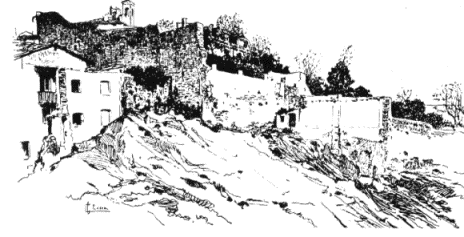(beside the remains of the Castellazzo, as it was at the end of the XIX century)

XIII CENTURY
At the beginning of the XIII century The Imperial authority on the Communes or on the feuds was almost non–existent. In fact, when Federico "Barbarossa" died, Germany was disrupted by civil wars and therefore the problem of the Italian local autonomies was neglected. Once Federico II was appointed King of Germany and of Italy in 1212 he showed a new interest in the Italian situation. Federico II had also inherited the Kingdom of Sicily and there he governed with intelligence and acuteness, neglecting the German part of his empire. He tried to constitute a state centralizedeliminating the local authorities of the local feudatories. This project was opposed or fostered by different people in the North of Italy.
Ivrea received with enthusiasm Federico II during the first days of February 1238 and other Piedmontese cities swore fidelity to him. In 1248 Federico allied with the Savoy and appointed Tommaso I of Savoy as Vicar of the Empire “ from Pavia above”: Therefore he was granted, among the others, the lands of Ivrea and of the Canavese.
The idea of unifying Italy vanished with the death of Federico II in 125O, and Germany lived a period of political crisis; for more than twenty years no emperor ruled and as a consequence the communal autonomy and the feudal one strengthened.
| In
Piedmont there was one of the greatest feudal families, that of the Marquises
of Monferrato whose territories bordered with the county of Ivrea; thus it was
inevitable that their aims to expand were addressed towards the Canavese: In 1278, after
alternate events, William the VII of Monferrato came by the
county of Ivrea. He had The Castle of St. Maurizio built which was again the seat and
symbol of the feudal power. (beside the remains of the Castellazzo, as it was at the end of the XIX century) |
|
The Commune
was forced to sign an agreement according to which Ivrea would choose as the "Podestà" (Governor) a Vassal or a Friend to the
Marquis who would govern the city according to its Statutes.